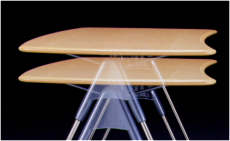
Cubed: A Secret History of the Workplace
Nikil Saval’s book Cubed: A Secret History of the Workplace pulls off that rare feat for a parochial business book of being intelligent and informed (which many are) as well as fascinating, entertaining and realistic, which is rather less commonplace. He pulls this off with plenty of references to pop culture including television series such as Will and Grace, films such as Office Space and The Apartment and, inevitably, the Dilbert cartoons. There is also a great deal of enjoyment to be had in the slightly jaded tone of his writing and brutal evisceration of the likes of Tom Peters who is singled out for special criticism. So too, his take on the very idea of the ‘Office of the Future’ with its slides, basketball courts, pool tables and vivid colours.
The fascination of his tale of work and workplaces over a number of centuries derives primarily from his framing of developments within the wider context of working culture, management thinking, social norms, economic trends, sexual politics and, of course, technological innovation. There is of course no other way but to view the design and management of the workplace and the things with which we fill it than in those terms. The design of a chair tells you a great deal about the person sitting in it, what they do, the tools they use, the organisation that bought it for them and the world outside.

President Kyo
In the case of Cubed, the later chapters are defined by one particular piece of office furniture that over the past 20 or 30 years has come to symbolise all that individuals associate with and hate about office life, especially in North America. The cubicle, which commentators in the media have claimed is 50 years old this year because it is most commonly associated with the launch of Herman Miller’s Action Office in 1964, is the touchstone for a generalised loathing of office life, seen as dehumanising and both capable of both isolating people and robbing them of their privacy and peace.
This makes perfect sense from a North American point of view and some other places, but robs the book of the perspective of what happens elsewhere in many parts of the world. Western and westernised societies have faced many of the same challenges but have responded to them in ways that reflect local culture and traditions, legislation, the commercial property market and the types of organisations involved. In the UK, for example, open plan never really meant cubicles. It meant clusters of workstations separated by low screens before this evolved into the now ubiquitous bench – rows of workstations which are often shared.
Such design paradigms and products evolved for the same reasons as the North American cubicle and in response to the same stimuli, and they are often disliked for the same reasons. But it is intriguing to note how cause and effect vary from place to place.

Vitra Ad Hoc
One other related point that the book omits is that many of the workplace design idioms we now see as mainstream arose twenty years ago in Europe in response to the changing world of work in the early to mid 1990s. The principles of freestanding furniture elements, shared space, a greater emphasis on teamworking, third space and so on were espoused in designs launched in this time. Indeed while 1994 is most commonly associated with the launch of the Aeron Chair, which the author rightly highlights as a base year for office seating design, it was also the year which saw the launch of Antonio Citterio’s Ad Hoc for Vitra and Kyo by President Office Furniture amongst others, both of which introduced a new way of talking about workplace design and were, arguably, ahead of their time in anticipating the office just around the corner.
These may be things for another time, however, given the breadth of knowledge and wit on display in Cubed. Recommended for anybody who is not only interested in the way offices are designed and managed but why things happen as they do.
____________________
 Colin Watson is managing director of the British Contract Furniture Association and Director General of FEMB (the European Federation of Office Furniture Trade Associations). www.thebcfa.com
Colin Watson is managing director of the British Contract Furniture Association and Director General of FEMB (the European Federation of Office Furniture Trade Associations). www.thebcfa.com
























July 15, 2014
Book Review: Cubed: A Secret History of the Workplace by Nikil Saval
by Colin Watson • Comment, Furniture, Work&Place, Workplace design
Cubed: A Secret History of the Workplace
Nikil Saval’s book Cubed: A Secret History of the Workplace pulls off that rare feat for a parochial business book of being intelligent and informed (which many are) as well as fascinating, entertaining and realistic, which is rather less commonplace. He pulls this off with plenty of references to pop culture including television series such as Will and Grace, films such as Office Space and The Apartment and, inevitably, the Dilbert cartoons. There is also a great deal of enjoyment to be had in the slightly jaded tone of his writing and brutal evisceration of the likes of Tom Peters who is singled out for special criticism. So too, his take on the very idea of the ‘Office of the Future’ with its slides, basketball courts, pool tables and vivid colours.
The fascination of his tale of work and workplaces over a number of centuries derives primarily from his framing of developments within the wider context of working culture, management thinking, social norms, economic trends, sexual politics and, of course, technological innovation. There is of course no other way but to view the design and management of the workplace and the things with which we fill it than in those terms. The design of a chair tells you a great deal about the person sitting in it, what they do, the tools they use, the organisation that bought it for them and the world outside.
President Kyo
In the case of Cubed, the later chapters are defined by one particular piece of office furniture that over the past 20 or 30 years has come to symbolise all that individuals associate with and hate about office life, especially in North America. The cubicle, which commentators in the media have claimed is 50 years old this year because it is most commonly associated with the launch of Herman Miller’s Action Office in 1964, is the touchstone for a generalised loathing of office life, seen as dehumanising and both capable of both isolating people and robbing them of their privacy and peace.
This makes perfect sense from a North American point of view and some other places, but robs the book of the perspective of what happens elsewhere in many parts of the world. Western and westernised societies have faced many of the same challenges but have responded to them in ways that reflect local culture and traditions, legislation, the commercial property market and the types of organisations involved. In the UK, for example, open plan never really meant cubicles. It meant clusters of workstations separated by low screens before this evolved into the now ubiquitous bench – rows of workstations which are often shared.
Such design paradigms and products evolved for the same reasons as the North American cubicle and in response to the same stimuli, and they are often disliked for the same reasons. But it is intriguing to note how cause and effect vary from place to place.
Vitra Ad Hoc
One other related point that the book omits is that many of the workplace design idioms we now see as mainstream arose twenty years ago in Europe in response to the changing world of work in the early to mid 1990s. The principles of freestanding furniture elements, shared space, a greater emphasis on teamworking, third space and so on were espoused in designs launched in this time. Indeed while 1994 is most commonly associated with the launch of the Aeron Chair, which the author rightly highlights as a base year for office seating design, it was also the year which saw the launch of Antonio Citterio’s Ad Hoc for Vitra and Kyo by President Office Furniture amongst others, both of which introduced a new way of talking about workplace design and were, arguably, ahead of their time in anticipating the office just around the corner.
These may be things for another time, however, given the breadth of knowledge and wit on display in Cubed. Recommended for anybody who is not only interested in the way offices are designed and managed but why things happen as they do.
____________________